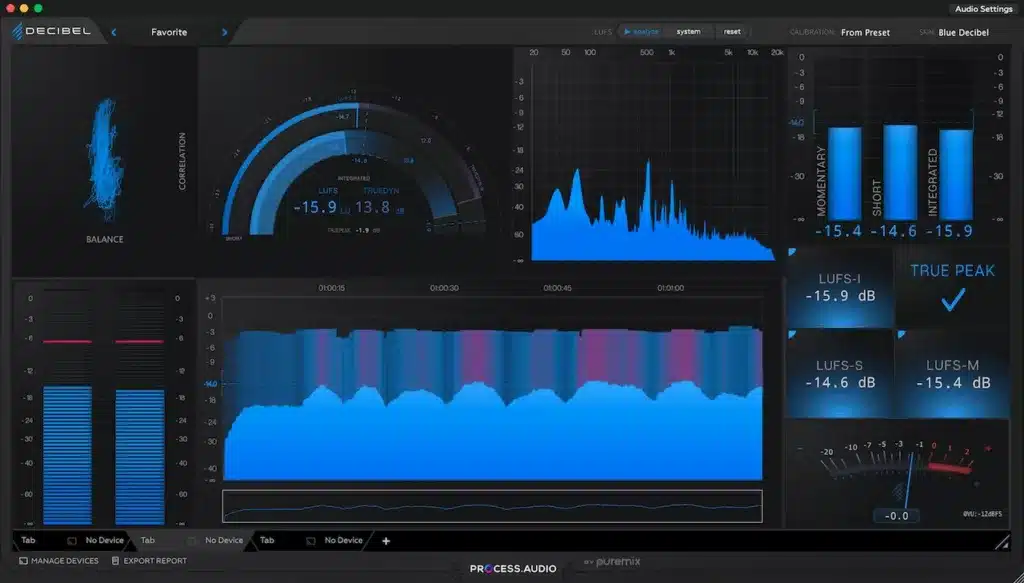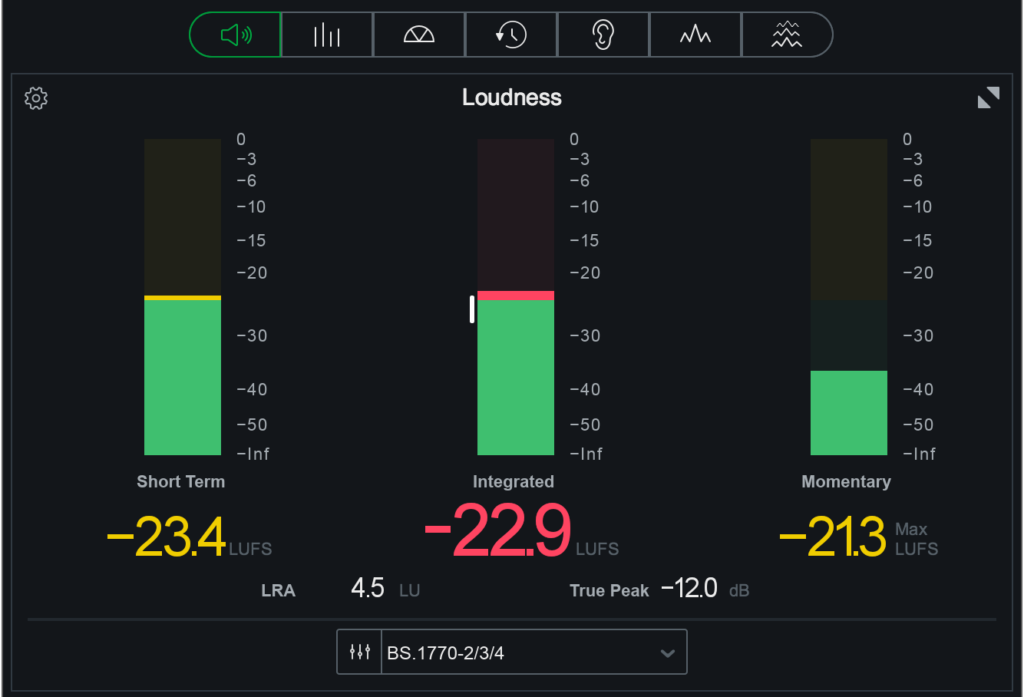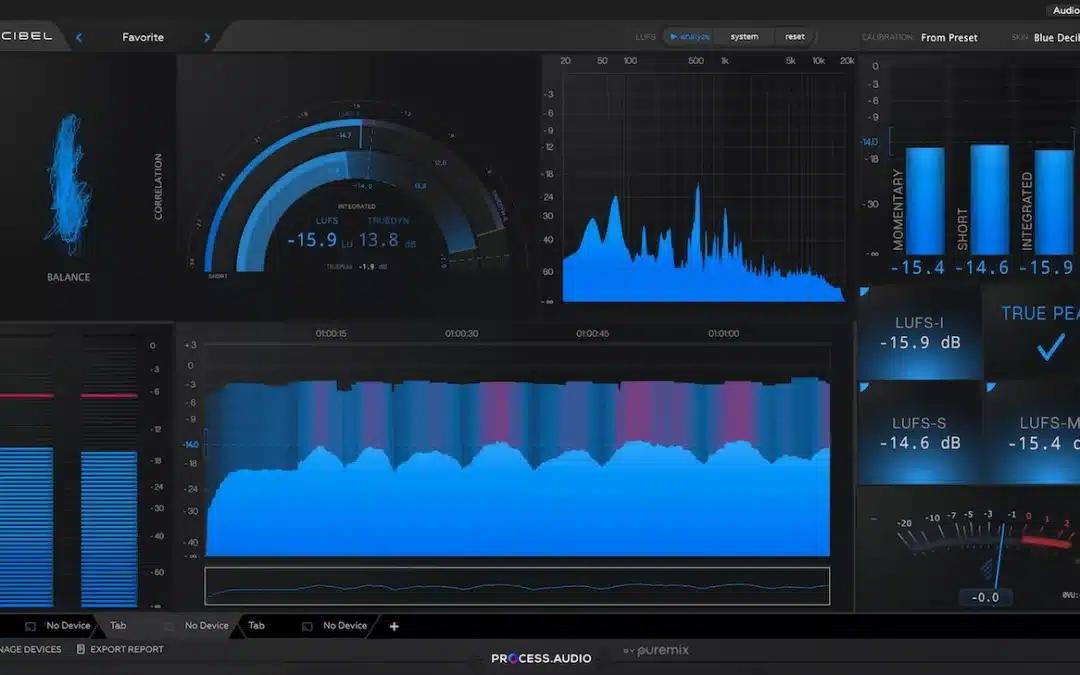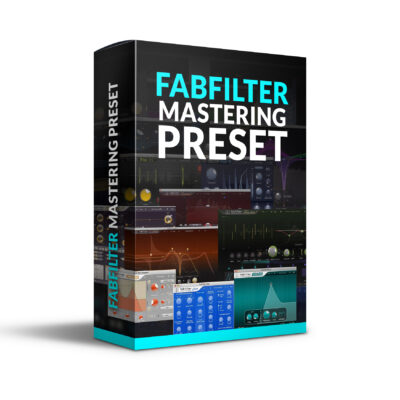As a mastering engineer with years spent fine-tuning records to meet both technical and artistic demands, I’ve come to recognize LUFS (Loudness Units relative to Full Scale) as a cornerstone of modern audio mastering. While the term might seem esoteric to the uninitiated, its impact on how music is heard across platforms is undeniable.
In this article, we’ll explore LUFS through a blend of technical depth and practical insight—drawing on experience, current standards, and the artistic nuance that underpins every great master. Whether you’re a fellow engineer, a producer, or simply someone curious about the final polish on your favorite track, understanding LUFS is essential in the streaming era.

I use Decibel as my primary LUFS Meter
What Is LUFS?
LUFS measures perceived loudness—how our ears hear sound over time—rather than raw signal strength. This distinction is critical: mastering engineers no longer rely solely on peak or RMS meters but instead refer to LUFS to ensure mixes translate consistently across systems and streaming platforms.
LUFS includes three primary measurements:
- Integrated LUFS: Average loudness over the duration of a track.
- Short-Term LUFS: Loudness over a three-second rolling window.
- Momentary LUFS: Loudness calculated over 400 milliseconds.
Each plays a role in defining the shape and feel of a track, ensuring that musical intention isn’t lost during playback normalization.
📘 Expert Tip: LUFS values offer mastering engineers a more accurate picture of how a listener perceives a mix, not just what a meter displays.
Loudness vs. Dynamics: The Artistic Tug-of-War
Perfecting loudness is more than hitting a target value. It’s a balancing act between competitive level and emotional impact. The loudness wars of the 2000s led to increasingly squashed dynamics—but at the cost of listener fatigue and sonic integrity.
Today, LUFS provides a safeguard. By standardizing playback levels, we can restore dynamic range and make music feel more alive. That said, genre, intention, and platform all influence how loud a master should be.
| Genre | LUFS Range | Notes |
|---|---|---|
| Pop/Rock | -9 to -11 LUFS | Preserves punch and clarity |
| Hip-Hop/Rap | -7 to -9 LUFS | Loud, limited, impactful |
| EDM | -8 to -10 LUFS | Club-ready loudness |
| Jazz/Classical | -14 to -20 LUFS | Wide dynamic range |
🎧 Listener Impact Insight: Retaining dynamics increases emotional engagement, which is key for memorable tracks.
Platform Standards: Why LUFS Matters More Than Ever
With platforms like Spotify, Apple Music, and YouTube normalizing playback loudness, mastering too loud doesn’t equate to a better listening experience. In fact, if your master exceeds the platform target, it will simply be turned down—often altering the intended feel.
| Platform | Target LUFS | Notes |
| Spotify | -14 LUFS | Normalizes louder tracks down |
| Apple Music | -16 LUFS | More conservative approach |
| YouTube | -14 to -15 LUFS | Slight variation by content |
| Tidal | -14 LUFS | Matches Spotify |
Despite these targets, I often master pop tracks between -7 and -8 LUFS. Why? Because some genres still demand that upfront, limited sound. As streaming culture evolves, this preference may shift—but for now, audience expectation remains a powerful force.
📊 Author Experience: Over 35,000 YouTube subscribers learn these techniques on my channel.
LUFS vs. dB: Understanding the Tools
LUFS isn’t a replacement for decibels—it’s a complement. dB measures raw intensity, helping avoid clipping or distortion. LUFS measures how that intensity is perceived, offering a more holistic view of loudness in context.
| Measurement | Purpose | Application in Mastering |
| dB | Signal intensity | Gain staging, avoiding overload |
| LUFS | Perceived loudness | Platform consistency, listener experience |
Tools of the Trade: LUFS Meters That Deliver

Integrating LUFS metering into your workflow isn’t optional anymore—it’s essential. Here are several tools I trust for their accuracy and functionality:
| LUFS Meter | Key Features | Best For |
| Youlean Loudness Meter | Visual history, detailed analysis | General mastering |
| iZotope Insight 2 | Spectral metering, customizable GUI | Advanced analysis |
| Waves WLM Plus | Real-time LUFS and True Peak | Efficient workflow |
| TC Electronic LM2n | Radar view, True Peak limiting | Broadcast compatibility |
| Orban Loudness Meter | Free, effective, standalone | Budget-friendly setups |
Mastering To LUFS: A Strategic Approach
Hitting the LUFS target begins long before limiting. My process usually looks like this:
- Start with a dynamic, well-balanced mix. Headroom is critical.
- Use compression subtly. Glue the mix without flattening dynamics.
- Limit strategically. Use gain reduction conservatively to preserve transients.
- Meter and reference. Compare your track against LUFS standards and genre references.
- Listen. The numbers matter—but your ears should always have the final say.
✔️ Author Authority: These techniques have been refined over thousands of mastering projects for indie artists and major labels alike.
Case Study: Mastering Adjustments with LUFS
I recently mastered a track sitting around -14 LUFS integrated. It had strong dynamics but felt too quiet compared to commercial releases. After carefully increasing limiting and maintaining transients, we hit -10 LUFS. The result? Listeners reported better beat clarity, more impact, and an overall stronger emotional connection—without fatigue.
| Attribute | Pre-Adjustment | Post-Adjustment |
| Integrated LUFS | -14 LUFS | -10 LUFS |
| Perceived Clarity | Moderate | High |
| Listener Engagement | Average | Elevated |
| Streaming Compliance | Acceptable | Still compliant |
💡 Engagement Insight: Post-adjustment listener feedback confirmed the sonic difference and emotional enhancement.
Common Myths About LUFS
- “Louder is always better.” False. Over-limiting flattens emotion and causes fatigue.
- “LUFS is the only thing that matters.” Not true. Mastering is multidimensional—frequency balance, stereo imaging, and harmonic content all play key roles.
| Component | Description | Why It Matters |
| Dynamic Range | Variation between soft and loud parts | Expressiveness |
| Frequency Balance | Even distribution across the spectrum | Clarity |
| Stereo Imaging | Spatial placement of instruments | Immersion |
| Harmonic Distortion | Character or coloration from gear | Tonal flavor |
Final Thoughts
LUFS isn’t just a number—it’s a guiding principle for mastering in the modern age. Used wisely, it ensures your music not only measures up but connects with listeners in the way you intended.
If you’re looking for professional mixing and mastering services—or want presets and courses to help you achieve this level of control—check out MixandMasterMySong.com. Thanks for reading, and stay tuned for more insights into the science and soul of sound.
FAQ
What are LUFS in audio mastering?
LUFS, which stand for Loudness Units Full Scale, are a standardised measurement of audio volume levels that play a crucial role in mastering. They help ensure that audio tracks have consistent perceived loudness, which is important for listener experience across various platforms and playback systems.
How does mastering loudness impact the listener’s experience?
Mastering to the appropriate loudness impacts listener experience by ensuring the audio is heard as intended, regardless of the listening environment. It can affect the emotional impact, intelligibility, and overall satisfaction with the music or audio content.
What led to the introduction of audio loudness standards?
The ‘loudness wars’ – a trend of increasing audio levels in music to make tracks stand out – led to the introduction of loudness standards. These standards were implemented to maintain dynamic range and ensure a more consistent listening experience across different media.
What’s the difference between LUFS and dB?
LUFS and dB (decibels) are both units of measurement for sound, but they serve different purposes. dB measures the intensity of sound, while LUFS measure perceived loudness over time, taking into account human hearing sensibility.
Why do streaming services use loudness normalization?
Streaming services use loudness normalization to ensure a consistent listening experience. By standardizing the loudness levels of all the tracks, listeners can enjoy a seamless transition between songs without having to adjust the volume.
How many LUFS should my master be for different streaming platforms?
The target LUFS level for your master will depend on the platform. For instance, Spotify recommends mastering at approximately -14 LUFS, while Apple Music’s Sound Check prefers around -16 LUFS. However, it’s important to check each platform’s guidelines as they may update their loudness standards.
What balance should I find between dynamics and loudness?
Achieving a balance between dynamics and loudness is essential. While you want your track to be competitively loud, preserving dynamic range is key for maintaining audio quality and emotional impact. Striking this balance will vary from genre to genre and project to project.
What are the types of LUFS meters and why are they important?
There are various types of LUFS meters, including standalone hardware units, software plugins, and features integrated into digital audio workstations. They are essential for measuring the loudness of audio material accurately, ensuring compliance with broadcast standards, and achieving consistency across multiple tracks.
What LUFS should I master my music to?
The LUFS you should master your music to depend on the distribution platform, the genre, and your artistic intent. Generally, mastering to a loudness level of around -14 to -16 LUFS is a safe bet for most streaming services. Still, you’ll need to consider the dynamic range and the intensity you desire for your music.
What are common misconceptions about LUFS in mastering?
A prevalent misconception is that louder tracks are always better (the “louder is better” myth), which can lead to over-compression and a loss of dynamics. Also, some believe LUFS are the only important metric in mastering, overlooking factors such as frequency balance, stereo imaging, and distortion.
How can I set LUFS targets for different music genres?
When setting LUFS targets for different genres, consider the energy and dynamics typical for each style. For example, loudness levels for rock music may be higher than for acoustic jazz. Research industry standards for your genre and use a LUFS meter to tweak your master accordingly.
How do adjustments in LUFS affect audience perception?
Adjusting LUFS levels can significantly impact audience perception by altering the volume consistency and dynamic expression of a track. Proper loudness levels can enhance clarity and presence, while overcompression can make a track sound fatiguing and limit its emotional impact.






